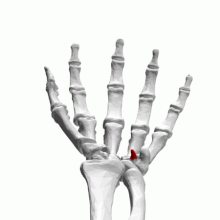| This article needs additional citations for verification. Please help improve this article by adding citations to reliable sources. Unsourced material may be challenged and removed. Find sources: "Hamulus" – news · newspapers · books · scholar · JSTOR (December 2009) (Learn how and when to remove this message) |
A hamus or hamulus is a structure functioning as, or in the form of, hooks or hooklets.
Etymology
The terms are directly from Latin, in which hamus means "hook". The plural is hami.
Hamulus is the diminutive – hooklet or little hook. The plural is hamuli.
Adjectives are hamate and hamulate, as in "a hamulate wing-coupling", in which the wings of certain insects in flight are joined by hooking hamuli on one wing into folds on a matching wing. Hamulate can also mean "having hamuli". The terms hamose, hamular, hamous and hamiform also have been used to mean "hooked", or "hook-shaped". Terms such as hamate that do not indicate a diminutive usually refer particularly to a hook at the tip, whereas diminutive terms such as hamulose tend to imply that something is beset with small hooks.
Anatomy

In vertebrate anatomy, a hamulus is a small, hook-shaped portion of a bone, or possibly of other hard tissue.
In human anatomy, examples include:
Arthropoda
In arthropod morphology, hamuli are hooklets, usually in the form of projections of the surface of the exoskeleton. Hami might be actual evaginations of the whole thickness of the exoskeleton. The best-known examples are probably the row of hamuli on the anterior edge of the metathoracic (rear) wings of Hymenoptera such as the honeybee. The hooks attach to a fold on the posterior edge of the mesothoracic (front) wings.
It is less widely realised that similar hamuli, though usually fewer, are used in wing coupling in the Sternorrhyncha, the suborder of aphids and scale insects. In the Sternorrhyncha such wing coupling occurs particularly in the males of some species. The rear wings of that suborder frequently are reduced or absent, and in many species the last vestige of the rear wing to persist is a futile little strap holding the hamuli, still hooking into the fold of the large front wings.
In those springtails (Collembola) that have a functional furcula, the underside of the third abdominal segment bears a hooked structure, variously called the retinaculum or hamula. It holds the furcula ready for release in times of emergency.
The terms also are used in descriptive anatomy of some insect genitalia, such as hamuli in various Odonata and "hamus" for the hooked part of the uncus in male Lepidoptera.
Botany
In botany, such words largely refer to hooked bristles such as the hooks on the rachilla of Uncinia, which attach the fruit to passing animals, or the similarly functioning hooks on Burdocks, well known as the alleged inspiration for Velcro.
References
- Jaeger, Edmund C. (1959). A source-book of biological names and terms. Springfield, Ill: Thomas. ISBN 0-398-06179-3.
- Jackson, Benjamin Daydon (2009). A Glossary of Botanic Terms, With Their Derivation and Accent: Includes free bonus books. Books LLC. ISBN 0-217-84753-6.
- A dictionary of scientific terms: pronunciation, derivation, and definition of terms in biology, botany, zoology, anatomy, cytology, embryology, physiology. Nabu Press. 2010. ISBN 1-171-91075-4.
- Carmine D. Clemente PhD (2010). Anatomy: A Regional Atlas of the Human Body (ANATOMY, REGIONAL ATLAS OF THE HUMAN BODY (CLEMENTE)). Hagerstwon, MD: Lippincott Williams & Wilkins. ISBN 1-58255-889-2.
- ^ Imms' General Textbook of Entomology: Volume 1: Structure, Physiology and Development Volume 2: Classification and Biology. Berlin: Springer. 1977. ISBN 0-412-61390-5.